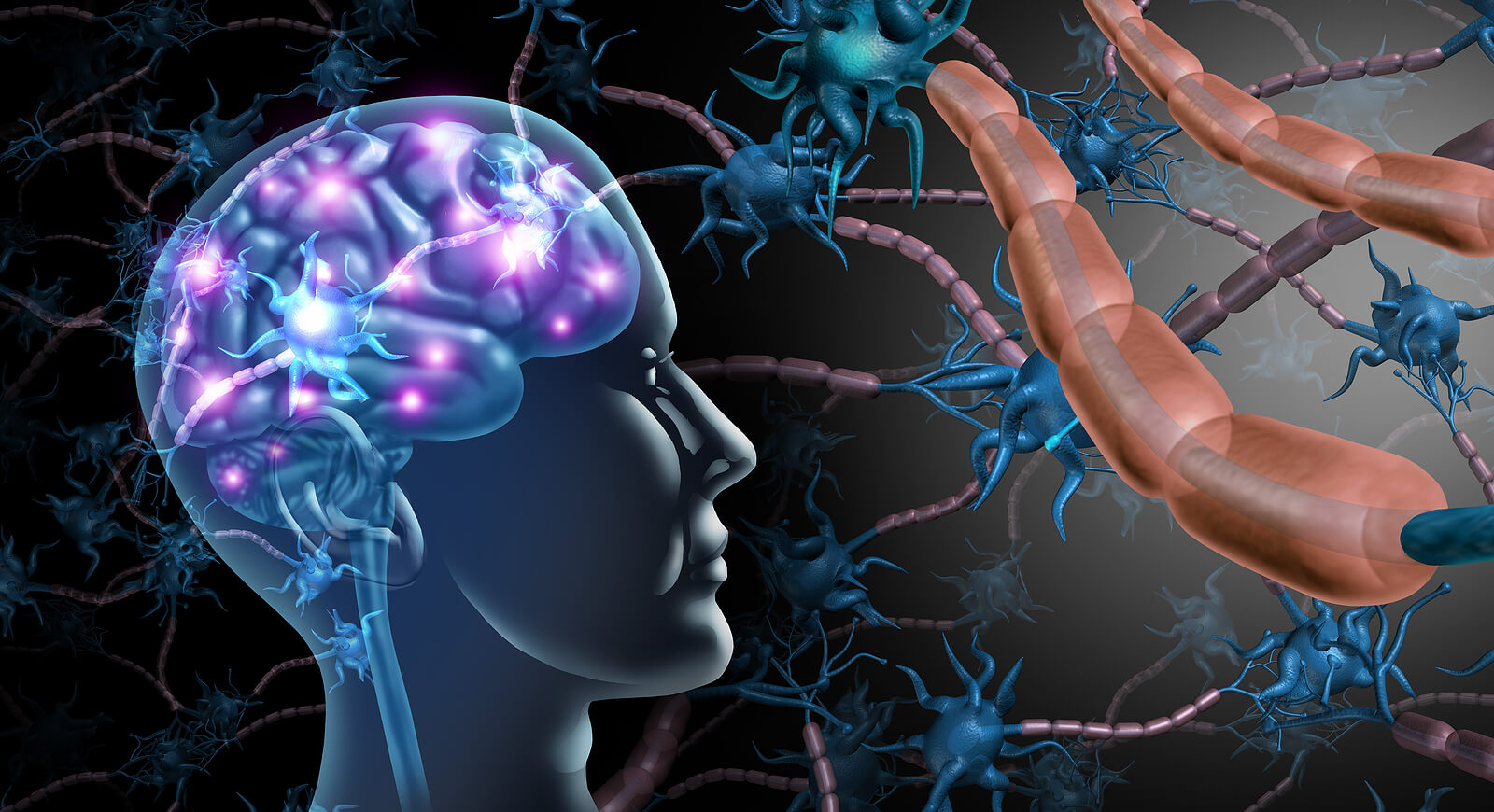Differences Between Multiple Sclerosis and ALS

Multiple sclerosis (MS) and amyotrophic lateral sclerosis (ALS) are chronic neurological diseases that tend to be confused despite their differences. Both are degenerative pathologies that affect the central nervous system, which cause high rates of disability worldwide. Stay with us as we look at the differences between multiple sclerosis and ALS.
MS is a chronic, demyelinating, inflammatory condition that is autoimmune in nature. Studies affirm that it’s the most frequent neurological pathology in young adults in North America and Europe. For its part, ALS or Lou Gehrig’s disease is characterized by the progressive degeneration of motor neurons and the spinal cord.
People tend to use both diseases synonymously, because they have the word “sclerosis” in common. However, there are several significant differences between multiple sclerosis and ALS associated with the mechanism of neuronal injury. ´Would you like to know more about the subject? Keep reading!
Differences between multiple sclerosis and ALS
MS and ALS are diseases of multifactorial origin that have an important hereditary component. Both entities alter the neuronal structure, nerve conduction, and motor activity. However, ALS and multiple sclerosis have key differences in their prevalence, symptoms, course, and prognosis.
1. Prevalence, sex and age of diagnosis

At present, several differences have been defined in terms of the prevalence and epidemiological characteristics of both conditions. Around 120 cases of MS are estimated per 100,000 inhabitants. For its part, some research indicates that ALS has a worldwide prevalence of 2 to 11 cases per 100,000 inhabitants.
In this way, MS provides up to ten times more cases than ALS. These pathologies are more common in adults, however their incidence varies according to sex and age. Amyotrophic lateral sclerosis is more common in men between 40 and 70 years, while multiple sclerosis is common in women between 20 and 40 years.
2. Mechanism of damage to the central nervous system
Neurological damage is different despite the fact that both pathologies affect similar nerve structures. MS causes an autoimmune lesion, so it’s the body itself that attacks the neural pathways. Damage usually occurs in myelin, an insulating substance that lines the nerves and allows proper conduction of the nerve impulse.
Demyelination will generate scars and permanent damage to the nerves over time, determining the poor prognosis of the disease and disability in people. In addition, various sensory or motor symptoms will originate depending on the area where the neuronal damage is generated.
The neuronal damage of ALS occurs in the motor pathway. This is a group of neurons that descend from the cortex to the spinal cord and are responsible for controlling voluntary movements. They degenerate progressively causing motor alterations and loss of muscle mass due to lack of nerve stimulation.
3. Associated symptoms
Some clinical manifestations may be similar in both pathologies, especially at the beginning of the disease. These symptoms are weakness, incoordination of movements, muscle stiffness, and difficulty moving. However, the obvious differences appear as multiple sclerosis and ALS progress.
The medical diagnosis of MS is characterized by motor, cerebellar, sensory, and spinal cord disorders. Some of the symptoms of multiple sclerosis are as follows:
- Fatigue
- Tingling and numbness of the extremities
- Visual disturbances
- Trouble walking
- Depression and mood swings
- Loss of balance
- Difficulty speaking
- Slow and blurry memory
On the other hand, ALS is a progressive weakness that can evolve into a total loss of muscle strength or paralysis. Similarly, affected people may suffer the following symptoms:
- Muscle cramps and spasms
- Difficulty speaking
- Swallowing and breathing problems
- Clumsiness and frequent falls
- Difficulty keeping the head upright
4. Evolution of the disease

Currently, there are several forms of multiple sclerosis. However, studies affirm that between 83 and 90% of those affected suffer from the relapsing-remitting form. The MS condition is characterized by episodes in flare-ups lasting 24 to 72 hours, which remit partially or totally.
Some people with MS may experience a full recovery from the disease. In addition, 15% of those affected suffer from the primary progressive form, which has a slow and sustained course over time. In general, patients experience cognitive decline, and the rate of progression varies from person to person.
ALS has a continuous and progressive course, the pace of which is usually accelerated in most people. Furthermore, there are no lapses of remission or latency and it isn’t accompanied by cognitive alterations. The life expectancy of patients with ALS varies between 3 to 5 years after diagnosis.
5. Diagnosis and treatment
Early identification of both pathologies is essential to determine a better prognosis for life. In most cases, the diagnosis of MS is based on symptoms, neurological evaluation, cerebrospinal fluid study, and magnetic resonance imaging.
The recognition of ALS involves greater difficulty due to its similarity with other pathologies and low prevalence. In general, the doctor should look for signs of neurological and motor impairment. In addition, complementary studies by electromyography, MRI, blood tests, and lumbar puncture are helpful.
Today, there’s no definitive cure for either of these conditions. For this reason, treatment is based on using drugs that help to slow the evolution of the disease accompanied by sessions of physiotherapy and occupational therapy. In the case of ALS, the treatment is mostly symptomatic.
Two types of sclerosis with a different evolution
Multiple sclerosis and ALS are pathologies that start in a similar way and have several differences as they evolve. The type of neurological damage is the key that determines the course of both pathologies. MS causes generalized demyelination, whereas in ALS the lesion is located in motor neurons.
Similarly, amyotrophic lateral sclerosis lacks sensory and cognitive symptoms, whereas in MS they’re evident. Early recognition of both conditions determines a better therapeutic response and a higher quality of life. If you have any questions, don’t hesitate to consult with your doctor.
Multiple sclerosis (MS) and amyotrophic lateral sclerosis (ALS) are chronic neurological diseases that tend to be confused despite their differences. Both are degenerative pathologies that affect the central nervous system, which cause high rates of disability worldwide. Stay with us as we look at the differences between multiple sclerosis and ALS.
MS is a chronic, demyelinating, inflammatory condition that is autoimmune in nature. Studies affirm that it’s the most frequent neurological pathology in young adults in North America and Europe. For its part, ALS or Lou Gehrig’s disease is characterized by the progressive degeneration of motor neurons and the spinal cord.
People tend to use both diseases synonymously, because they have the word “sclerosis” in common. However, there are several significant differences between multiple sclerosis and ALS associated with the mechanism of neuronal injury. ´Would you like to know more about the subject? Keep reading!
Differences between multiple sclerosis and ALS
MS and ALS are diseases of multifactorial origin that have an important hereditary component. Both entities alter the neuronal structure, nerve conduction, and motor activity. However, ALS and multiple sclerosis have key differences in their prevalence, symptoms, course, and prognosis.
1. Prevalence, sex and age of diagnosis

At present, several differences have been defined in terms of the prevalence and epidemiological characteristics of both conditions. Around 120 cases of MS are estimated per 100,000 inhabitants. For its part, some research indicates that ALS has a worldwide prevalence of 2 to 11 cases per 100,000 inhabitants.
In this way, MS provides up to ten times more cases than ALS. These pathologies are more common in adults, however their incidence varies according to sex and age. Amyotrophic lateral sclerosis is more common in men between 40 and 70 years, while multiple sclerosis is common in women between 20 and 40 years.
2. Mechanism of damage to the central nervous system
Neurological damage is different despite the fact that both pathologies affect similar nerve structures. MS causes an autoimmune lesion, so it’s the body itself that attacks the neural pathways. Damage usually occurs in myelin, an insulating substance that lines the nerves and allows proper conduction of the nerve impulse.
Demyelination will generate scars and permanent damage to the nerves over time, determining the poor prognosis of the disease and disability in people. In addition, various sensory or motor symptoms will originate depending on the area where the neuronal damage is generated.
The neuronal damage of ALS occurs in the motor pathway. This is a group of neurons that descend from the cortex to the spinal cord and are responsible for controlling voluntary movements. They degenerate progressively causing motor alterations and loss of muscle mass due to lack of nerve stimulation.
3. Associated symptoms
Some clinical manifestations may be similar in both pathologies, especially at the beginning of the disease. These symptoms are weakness, incoordination of movements, muscle stiffness, and difficulty moving. However, the obvious differences appear as multiple sclerosis and ALS progress.
The medical diagnosis of MS is characterized by motor, cerebellar, sensory, and spinal cord disorders. Some of the symptoms of multiple sclerosis are as follows:
- Fatigue
- Tingling and numbness of the extremities
- Visual disturbances
- Trouble walking
- Depression and mood swings
- Loss of balance
- Difficulty speaking
- Slow and blurry memory
On the other hand, ALS is a progressive weakness that can evolve into a total loss of muscle strength or paralysis. Similarly, affected people may suffer the following symptoms:
- Muscle cramps and spasms
- Difficulty speaking
- Swallowing and breathing problems
- Clumsiness and frequent falls
- Difficulty keeping the head upright
4. Evolution of the disease

Currently, there are several forms of multiple sclerosis. However, studies affirm that between 83 and 90% of those affected suffer from the relapsing-remitting form. The MS condition is characterized by episodes in flare-ups lasting 24 to 72 hours, which remit partially or totally.
Some people with MS may experience a full recovery from the disease. In addition, 15% of those affected suffer from the primary progressive form, which has a slow and sustained course over time. In general, patients experience cognitive decline, and the rate of progression varies from person to person.
ALS has a continuous and progressive course, the pace of which is usually accelerated in most people. Furthermore, there are no lapses of remission or latency and it isn’t accompanied by cognitive alterations. The life expectancy of patients with ALS varies between 3 to 5 years after diagnosis.
5. Diagnosis and treatment
Early identification of both pathologies is essential to determine a better prognosis for life. In most cases, the diagnosis of MS is based on symptoms, neurological evaluation, cerebrospinal fluid study, and magnetic resonance imaging.
The recognition of ALS involves greater difficulty due to its similarity with other pathologies and low prevalence. In general, the doctor should look for signs of neurological and motor impairment. In addition, complementary studies by electromyography, MRI, blood tests, and lumbar puncture are helpful.
Today, there’s no definitive cure for either of these conditions. For this reason, treatment is based on using drugs that help to slow the evolution of the disease accompanied by sessions of physiotherapy and occupational therapy. In the case of ALS, the treatment is mostly symptomatic.
Two types of sclerosis with a different evolution
Multiple sclerosis and ALS are pathologies that start in a similar way and have several differences as they evolve. The type of neurological damage is the key that determines the course of both pathologies. MS causes generalized demyelination, whereas in ALS the lesion is located in motor neurons.
Similarly, amyotrophic lateral sclerosis lacks sensory and cognitive symptoms, whereas in MS they’re evident. Early recognition of both conditions determines a better therapeutic response and a higher quality of life. If you have any questions, don’t hesitate to consult with your doctor.
- Pericot I, Montalban X. Esclerosis múltiple. Medicina integral. 2001 Jun; 38 ( 1 ): 18:24.
- Zapata-Zapata C, Franco-Dáger E, Solano-Atehortúa J, Ahunca-Velásquez L. Esclerosis lateral amiotrófica: actualización. Iatreia. 2016 June; 29( 2 ): 194-205.
- Carretero Ares J, Bowakim Dib W, Acebes Rey J. Actualización: esclerosis múltiple. Medifam. 2001 Nov; 11( 9 ): 30-43.
- Osorio-Marcatinco V, Castro-Suarez S, Meza-Vega M. Características del estado cognitivo de pacientes con esclerosis múltiple remitente – recurrente durante el brote en el Instituto Nacional de Ciencias Neurológicas 2014 – 2016. Rev Neuropsiquiatr . 2018 Abr; 81( 2 ): 58-64.
- Cuevas-García CF, Segura-Méndez NH, Herrera-Sánchez DA. [Actualidades en la inmunopatología de la esclerosis múltiple]. Gac Med Mex. 2018;154(5):588-597.
- Flores L, Gabriel-Ortiz G, Pacheco-Moisés F, Bitzer- Quintero O. Mecanismos patogénicos en el desarrollo de la esclerosis múltiple: ambiente, genes, sistema inmune y estrés oxidativo. Invest. clín . 2015 Jun ; 56( 2 ): 201-214.
Este texto se ofrece únicamente con propósitos informativos y no reemplaza la consulta con un profesional. Ante dudas, consulta a tu especialista.







